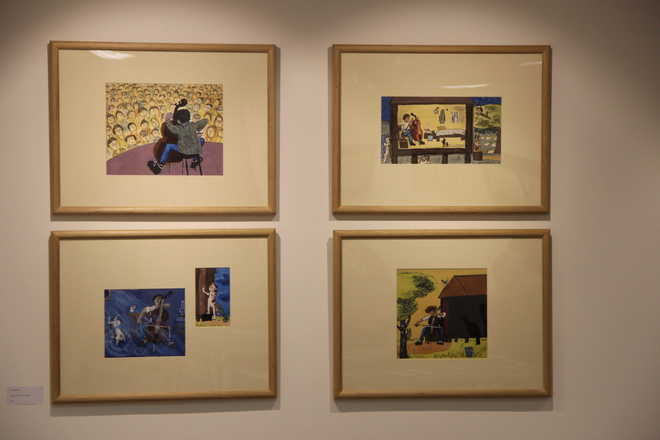
CATCH ’EM YOUNG: Displays at the the exhibition, Chihiro Iwasaki and Picture Books of Japan
Neha Kirpal
IN Takeshi Motai’s Gorsh the Cellist, Gorsh is not good at playing the cello and is always scolded by his orchestra conductor. The concert is in 10 days’ time. Encouraged by different animals who visit him night after night, Gorsh practices hard and succeeds wonderfully on stage at the concert. In Suekichi Akaba’s Fly away, birdies!, a traveller, hastily running down the road, meets a dog who barks at him. The birds printed on his clothes are surprised and fly away. Over the hills, over the mountains... the chase of the traveller begins to catch the birds.
These timeless tales are among the several picture books for children on display as part of an exhibition Chihiro Iwasaki and Picture Books of Japan at The Japan Foundation in New Delhi. In association with the Chihiro Art Museum, the exhibition brings alive the culture of pictorial books in children’s literature that has been a part of Japanese society since centuries.
Iwasaki (1918-74) was an award-winning illustrator of children’s books. Apart from picture books, her charming illustrations of flowers and children also appeared in magazines, textbooks, novels and calendars. One of her most best-selling books was Tetsuko Kuroyanagi’s Totto-Chan (1981) or The Little Girl at the Window. The charming story recounts the childhood of Tetsuko Kuroyanagi, focusing on her days in elementary school, Tomoe Gakuen, known for its unique educational method even during the time of the war. In 1996, the book was translated and published in Hindi by the National Book Trust.
As part of the Foundation’s efforts to introduce Japanese arts and culture to the world, the exhibition also features works about the history of other Japanese picture books from the 8th to 20th century. Japan has a long tradition of picture books, such as picture scrolls and hand-drawn picture books such as Nara Ehon from the Heian era and wood-block print books such as Ezoshi from the Edo period (1603-1868). During the Taisho era (1912-26), when there were active movements for a democratic society, various artistic magazines for children began to be published. Until the beginning of Showa era (1926-89), several artists for children such as Kiichi Okamoto (1888-1930), Takeo Takei (1894-1983) and Shigeru Hatsuyama (1897-1973) flourished. This was the golden age of children’s books in Japan. After World War II and until the mid-1950s, Takeshi Motai (1908-56) was popular in Japan. From the mid-1960s to 1970s, artists such as Suekichi Akaba (1910-90), Shinto Cho (1927-2005), Yasuo Segawa (1932-2010) and Chihiro Iwasaki contributed to the medium with numerous picture books, many of which are read to this day.
Visitors at the exhibition commended the importance of art, alongside stories as a valuable means to educate children. Jyoti Rai, a housewife, said her seven-year-old daughter does not like to read much. “A picture book, on the other hand, is colourful and it grasps her attention more than a book with a lot of words would,” she said. Cindy Shaw, a tourist at the exhibition, emphasised that the form is visually stimulating: “Children learn faster by looking at pictures.”



























